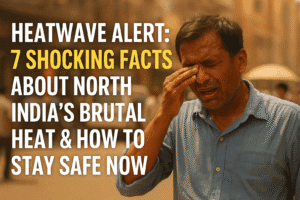Heatwave Alert: 7 Shocking Facts About North India’s Brutal Heat & How to Stay Safe Now
North India endures extreme heat, with Delhi hitting 43.8°C and Himachal’s Una scorching at 44.2°C – unprecedented for hill regions. Trapped residual moisture amplifies discomfort, making temperatures feel far hotter (Delhi’s heat index nears 49°C). Rajasthan faces emergency conditions, with Ganganagar above 47°C triggering IMD’s red alert. Relief hinges on monsoon revival (expected mid-June), though isolated thunderstorms may bring fleeting respite to Himachal around June 13-14 and broader North India around June 15-16. Crucially, vulnerable groups must avoid 11 AM–4 PM exposure and recognize heatstroke signs (dizziness, no sweating). Until sustained rain arrives, prioritize hydration and shade, especially in urban “heat islands” like Delhi and Ludhiana where temperatures won’t dip below 40°C until at least June 16.

Heatwave Alert: 7 Shocking Facts About North India’s Brutal Heat & How to Stay Safe Now
While Delhi’s 43.8°C and Una’s record 44.2°C dominate headlines, the real crisis lies in what thermometers don’t show: residual moisture trapping heat like a steam bath. This invisible humidity – left behind by fading western disturbances – makes 43°C feel like 49°C in Delhi, turning routine activities into health hazards.
Where the Heat Hits Hardest
- Rajasthan’s Furnace: Ganganagar’s 47°C+ temperatures triggered IMD’s rare red alert (June 11-12) – signaling “very high likelihood of heat illness.”
- Himalayan Distress: Hill stations aren’t escaping. Una’s 44.2°C proves elevation no longer guarantees respite, with Shimla and Manali baking abnormally.
- Urban Pressure Cookers: Delhi and Ludhiana face prolonged 40°C+ temperatures with critical infrastructure strain as power demand soars.
Why This Feels Relentless
The delayed monsoon’s absence (now expected mid-June) combines dangerously with:
- Trapped moisture amplifying “feels-like” temperatures
- Minimal nighttime cooling (Delhi’s lows: 29-30°C)
- Dwindling water reserves in villages near heat epicenters
The Turning Point: What to Expect
| Date | Region | Change |
| June 13-14 | Himachal Pradesh | Isolated light rain (brief relief) |
| June 15-16 | North India | Thunderstorms likely |
| June 18-20 | East Rajasthan | Meaningful temperature drop |
Human Survival Strategies Now
- Health First: Orange/yellow alerts mean high-risk groups (elderly, laborers) should avoid 11 AM-4 PM exposure. Recognize heatstroke signs: sudden dizziness, no sweating.
- Urban Adaptations: Use wet curtains on windows, prioritize rehydration with electrolytes, and check on vulnerable neighbors daily.
- Water Wisdom: In drought-affected areas, prioritize drinking water over non-essential uses like car washing.
The Bigger Picture
This event exposes a harsh pattern: heatwaves are reaching higher elevations earlier in summer. While immediate relief is coming, the recurrence demands long-term solutions – from urban green corridors to revised labor laws for outdoor workers.
You must be logged in to post a comment.